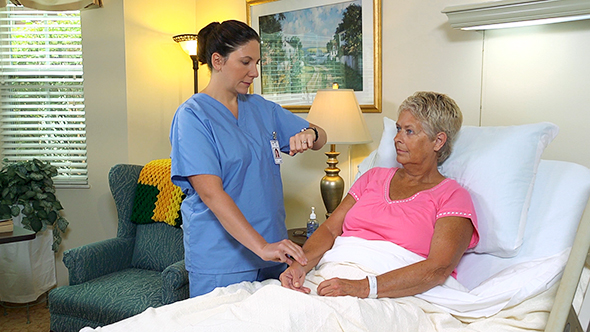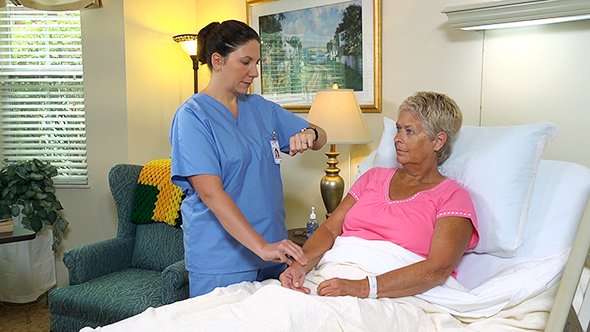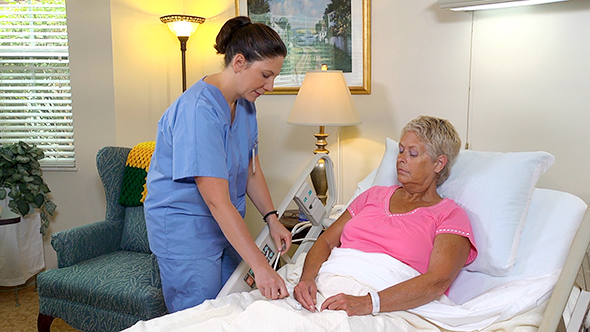Measurements and Vital Signs
Select a Skill:
- » Measuring Weight and Height
- » Taking a Radial Pulse
- » Taking an Apical Pulse
- » Counting Respirations
- » Taking a Temperature with an Electronic Thermometer
- » Measuring Blood Pressure
- » Using a Pulse Oximeter
Take the Review Test:

Purpose

- Respiration means breathing air into (inhalation) and out of (exhalation) the lungs. Each respiration involves one inhalation and one exhalation. The chest rises during inhalation. It falls during exhalation.
- The healthy adult has 12 to 20 respirations per minute. The respiratory rate is affected by many factors, including activity, drugs, anxiety, eating, and pain. Heart and respiratory diseases often increase the respiratory rate.
- Respirations normally are quiet, effortless, and regular. Both sides of the chest rise and fall equally.
- People tend to change their breathing patterns when they know their respirations are being counted. Therefore, do not tell the person that you are counting them. Count respirations right after taking a pulse. Keep your fingers or stethoscope over the pulse site. The person assumes you are taking the pulse.
- To count respirations, watch the chest rise and fall. Count them for 30 seconds. Multiply the number by 2 for the number of respirations in 1 minute.
- If you note an abnormal pattern, count respirations for 1 minute.
- In some agencies, respirations are counted for 1 minute. Follow agency policy.
Equipment
Roll cursor over items to see labels. For the purposes of clearly depicting the equipment, a barrier is not shown in this photo. When providing care, a barrier should always be placed on the surface before placing the equipment.

Watch with a second hand
Delegation
- Follow delegation guidelines. Before counting respirations, obtain this information from the nurse and care plan:
- How long to count respirations for each person—30 seconds or 1 minute
- When to count respirations
- If the nurse has concerns about certain patients or residents
- What other vital signs to measure
- What observations to report and record
- When to report observations
- What patient or resident concerns to report at once
Preparation

- Observe quality-of-life measures.
- Review the information under Delegation.
- Practice hand hygiene.
- Identify the person. Check the ID bracelet against the assignment sheet. Also call the person by name.
- Provide for privacy.
Safety
- This skill does not include safety content.
Comfort
- Make sure the person is in a comfortable position to prevent labored breathing as much as possible.
Procedure Video
Audio Description: OFFFollow-up Care

- Provide for comfort.
- Place the call light within reach.
- Unscreen the person.
- Complete a safety check of the room.
- Practice hand hygiene.
Reporting/Recording
- Report and record your observations, including:
- The respiratory rate
- Equality and depth of respirations
- If the respirations were regular or irregular
- If the person has pain or difficulty breathing
- Any respiratory noises
- Abnormal respirations—report at once
Review Questions
Select the best answer.
1. What is the normal respiratory rate for an adult?
 6 to 12 breaths per minute
6 to 12 breaths per minute 12 to 20 breaths per minute
12 to 20 breaths per minute 20 to 26 breaths per minute
20 to 26 breaths per minute 26 to 32 breaths per minute
26 to 32 breaths per minute
Select the best answer.
2. When is the best time to count respirations?
 After taking a radial pulse while still holding the wrist
After taking a radial pulse while still holding the wrist After taking a temperature while the thermometer is still in the ear
After taking a temperature while the thermometer is still in the ear Before taking an apical pulse while the stethoscope is still on the arm
Before taking an apical pulse while the stethoscope is still on the arm After taking the blood pressure while the stethoscope is still on the arm
After taking the blood pressure while the stethoscope is still on the arm
Select the best answer.
3. Which respirations should you report to the nurse at once?
 14 breaths per minute and quiet
14 breaths per minute and quiet 18 breaths per minute and regular
18 breaths per minute and regular 20 breaths per minute and normal
20 breaths per minute and normal 24 breaths per minute and shallow
24 breaths per minute and shallow
Select the best answer.
4. If the respiratory rate is regular and if permitted by agency policy, how should you count respirations?
 Count the rate for 10 seconds and multiply by 6.
Count the rate for 10 seconds and multiply by 6. Count the rate for 15 seconds and multiply by 4.
Count the rate for 15 seconds and multiply by 4. Count the rate for 20 seconds and multiply by 3.
Count the rate for 20 seconds and multiply by 3. Count the rate for 30 seconds and multiply by 2.
Count the rate for 30 seconds and multiply by 2.
Select the best answer.
5. Which of these factors may affect the respiratory rate?
You have completed the Review Questions for this skill. To take the Review again select the Start Over button. To proceed to another skill select from the dropdown menu. Select the Home or Back button to proceed to the next section.

